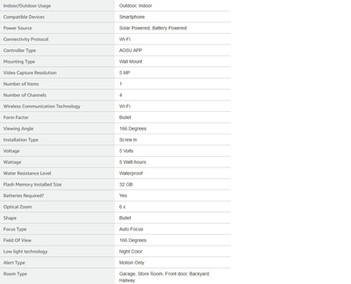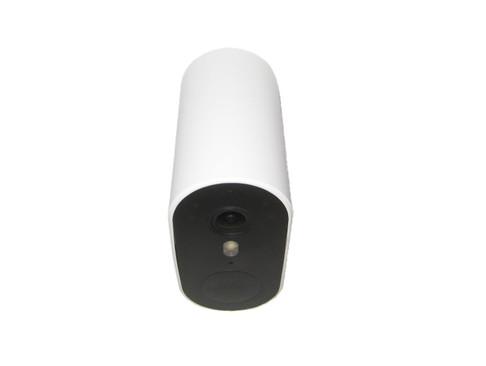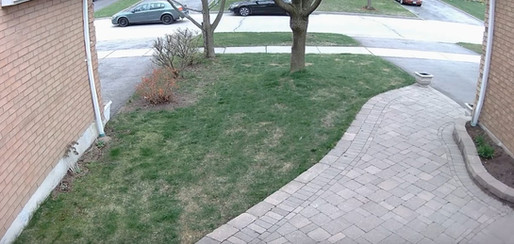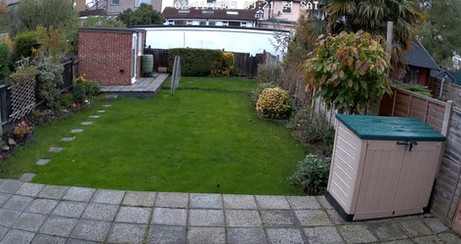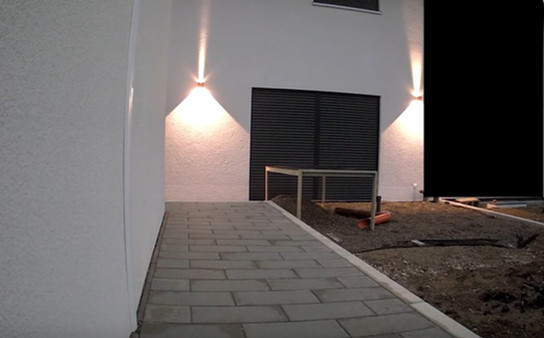AOSU SolarCam System Max
- Alexandros Boukanov
- Aug 4, 2024
- 9 min read
Updated: Jan 8

Great outdoor security cameras can cost a pretty penny. While there are plenty of excellent options out there, they aren’t necessarily cheap, meaning that if you want something low-cost, you often have to sacrifice on quality. That’s where the AOSU SolarCam System Max comes in. Designed to offer excellent quality at a lower price, this AOSU security camera System certainly has an uphill battle ahead of it, considering how well-established the other players are. AOSU SolarCam System Max is completely Wire-Free and it comes with 2 outdoor/indoor cameras, 2 solar panels and a base station to store your recordings and to make sure the cameras always have a good WiFi connection. So the cameras are battery powered and have a built-in 9200mAh battery and according to AOSU it should last anywhere between 4-8 months depending on how often the cameras wake up and starts to record.
Specifications:
Packaging & Contents

The packing box is made of a cardboard box and it comes in a blue/white design. The front side of the box has AOSU's logo printed on the top left side with 5MP name on the right. There is a picture of the SolarCam System Max on the main section.

The back side of the box mention the accessories.

The left side of the box has the features.

The right side has info about the app and a QR code for quick access to product information.

It is very well-protected. Inside, the appliance itself is protected by huge foam spacers, and is also wrapped in a plastic bag.

The camera is supplied with all the necessary accessories. These include the solar panel with bracket, two sets of dowels and drilling templates, and the instructions. No memory card is included in the delivery.
What's in the box?
2 x Outdoor security cameras.
1 x Base station.
2 x Solar panels.
2 x Camera brackets.
2 x Solar panel brackets.
2 x USB-C charging cables.
2 x Security monitoring stickers.
Multiple wall plugs and fixing screws.

The operating instructions are available in many languages. Most of the steps are self-explanatory and easy to understand.
A Closer Look
The face of camera is black and pill-shaped while the rest of the camera is a stark white. It’s pretty minimalist and sleek, a look I’m definitely into. The cameras record in 2592 x 1944 and use a 166 degree wide angle lens. They also have a built-in spotlight for full color night vision, and how it works is that when the camera detects motion it will automatically turn on the spotlight and record in full color. It will use infrared night vision when the spotlight is turned off.

The sync button and USB-C socket/plug port for the solar cell is located on the bottom of the camera. It is important to mount the camera the right way up to prevent water ingress. The cable is relatively long at 1.5 m. Another nice thing with these cameras is that they have a IP66 rating, which means they are weatherproof and can be placed outdoors in the rain. They also support 2-way audio so you can talk and listen through the cameras.

The rear features the mounting area. We find a screw thread, allowing the cameras to be fixed by screwing them to their support. I prefer some kind of magnetic fixation.

The solar cam from Aosu scores with a wide field of view and can be rotated by almost 360° in the app. A viewing angle of 90° downwards is also possible.

The rear features the mounting area. We find a screw thread, allowing the cameras to be fixed by screwing them to their support. The manufacturer also provides two USB to USB-C cables, in order to recharge them.

The Homebase unit is relatively compact and lightweight.

It features an LED indicator light, a speaker, an Ethernet port for router connection, a USB port, power port, and a sync button. I would like to see the ability to turn off the base station LED in a future update, as you can with the cameras.

The cameras are connected to the base station using WiFi and then the base station is connected to your router using a network cable. This gives a more stable connection compared to if the cameras was connected directly to your router. Also the base station works as a NVR to store the recordings on and it supports up to 32GB MicroSD card. With the built-in 32GB memory, offering up to 120 days of video recording (4-month loop recording) without the need for a subscription. All your data is securely encrypted and stored locally, ensuring privacy and ease of access. The camera offers cloud storage options and there is a free 7-day trial version. As always, the subscription will cost a lot of money in the long run.
Current prices.
1 camera, 7 days storage, annual subscription: 30 €
1 camera, 14 days storage, monthly subscription: €4.50
1 camera, 14 days storage, annual subscription: €44.50
2 cameras, 14 days storage, annual subscription: 80 €
App

First, you download the Aosu app for Android from Google Play and register with a few details. This process is quick and straightforward. Once the app is installed, the new camera is immediately recognized and integrated into the existing system. There was an immediate firmware update to the base station and to both cameras when I first set them up. This can take up to 5 minutes. Once this is done, we select the system with 2 cameras, then we must start the 2 cameras, by pressing the “SYNC” button, this is where a very cheap sound is heard by the cameras, but nothing dramatic in that. You also have to press the station's synchronization button in order to synchronize all the cameras with this station, which doesn't seem very complicated.

Pairing was easy and within seconds all my cameras were up and showing signals between 90-100 percent wifi signal based on where you install. If your camera is still too far away from the WiFi and the signal strength falls below 50%, it is recommended to switch the camera from 2K to HD. This ensures that the videos are smaller but can be transmitted more reliably at a lower speed! The camera can be configured via the app. Starting with the orientation of the camera and video resolution.

There is an option to make it full screen on your phone and you can pinch or push to make what you are looking at a bit closer. It doesnt actually zoom the cameras, but you can look closer at what the person is wearing or who they are that way.

You can easily switch between cameras, capture an image, or look at multiple cameras at the same time. It has a very small delay on notifications to let you know it detected motion but I think that is due to WiFi limitations and speed of connection also. The one thing I wish could be improved is the length of recording time. Unless you push to manually record the longest the camera will store one event is 60 seconds. The app does have a spot to store these events. It will keep each one under an event tab for each camera so you can go back to view them or download them to your phone.

The motion detection (without cloud subscription) is adjustable, for example, only Humans so that cats don't beep, you can also adjust their sensitivity, a small scheme explains either which one you should choose or self-adjust. The camera always records events, but it only sends a notification to the mobile phone when you want, you can choose time slots, with a fast immediate mode but it detects the difference between human and cat, and a better but slightly slower intelligent mode (both are fast, there's not much difference). You can choose for each camera whether to record sound or not. If the solar panel does not charge the camera properly, you will receive an alert. You can share access to view the cameras with other people, they must install the app and create an account, then you invite them from your app by adding their email and that's it. You can activate or not the LED light that indicates the start of the camera. It is compatible with Alexa and Google Assist.

In detail, you can access the serial number of the camera, see the signal strength between the base and the camera, delete local events, change the name of the camera. In the base sheet report you can see how much memory you are using from the base and how many cameras are connected to that base. There is a firmware update section that lets you know if necessary, it's super simple to just follow what the app says. There's a quick start option that tells you how to configure all that and guides you, but it's really not that complicated and the app is nice, I don't think anyone would find that complicated. There is an option to unlink a camera if necessary. The base has its own section where you can change the name and see its storage capacity. If the battery level is low, a message will appear on the push phone. There is a technical service shutdown like a chat in the app that answers well, it doesn't respond super fast, but it's reasonable and at least it answers you like others or that.
Performance

We charged the cameras once at the beginning. The instructions for wall mounting are easy to follow and all necessary parts supplied. The camera's holding arm allows you to position and perfectly aim the camera in virtually any direction. Then we hooked up the solar panel to that camera and it charged itself back up to 100% without me having to take the whole camera down and hook it up to a power source.

Watch about 3 hours on the panels. And yet the battery is ALWAYS at 100%. Just great. You don't have to worry about that in winter when the sun isn't shining.
The image quality depends on your wifi and internet connection, for UHD, wifi 5 minimum and a good internet speed otherwise you have a poorer image quality. The camera speaker has a regular quality like all these types of cameras. During the day, the video was, as expected great, with the colors a bit on the contrasty side, but overall, it does look very sharp and the objects are well defined even in the distance.
This SolarCam works well with low light.
If you prefer color, you can use the four built-in LED lamps, which illuminate the scene well up to 10m.
Final Thoughts

The AOSU SolarCam System Max strikes a great balance between features for an outdoor security camera, while coming in at a price below many premium cameras with the same features. Perhaps one of the coolest things about this camera is that it’s available with a solar panel, which means you’ll never have to worry about charging it. To be clear, there are other security cameras that work with solar panels for continuous power, so it’s not necessarily unique. But, most of the time, if you buy two 5MP cameras and two solar panel together, you’ll expect to pay more than €280, which is way over of this AOSU SolarCam System Max at €206.
The solar panel charges the camera quickly although installation is limited to areas with adequate sunlight exposure. When I set up the camera, it had 64% battery. However, by the end of the day it was fully charged. Even if you have a run of bad weather and cloudy days, you shouldn’t have to worry too much about battery life. The SolarCam System Max may be inexpensive, but it still offers a generally high video quality. The camera offers a resolution of 2592 x 1944 pixels. The 166-degree wide angle of the cameras is also impressive because a camera monitors a very large area which means that you don't need as many cameras to film everything around the house, for example. On top of that, you’ll get 6x optical and there’s a LED spotlight that can be used to capture color night vision, or if you need longer distance night video, the camera has infrared LEDs for black-and-white night vision at up to 33 feet. Generally speaking, I found the video quality to be clear and detailed, with solid color reproduction. That included at night, though ultimately I opted for the black-and-white video due to needing better video at longer distances. This x2 cameras along with a (I think) Solid State Home Hub is fantastic. The base station has a built-in 32gb storage, so there's no need for an SD card and we can use it straight away, which is great for first-time users. Unfortunately, there is no SD card slot in any of the cameras, and the base station has a USB port, but this is only for charging the cameras, which is a shame. I was hoping we could use the USB port as extra storage, so we could have larger storage capacity. No need to pay for subscription, but it has an option to pay for cloud storage, but it's optional. The SolarCam is weather proof no need to worry about rain/snow/high temperatures. Installation is very easy thanks to the included dowels. All you need to do is drill 5x holes for each camera, screw them onto your property, plug the Home hub into your router with the supplied CAT6 and your done. I was particularly impressed by the wall mount. It is a plug-in connection that allows the camera to be easily removed. A flexible standard wall mount is included for the solar cell, which is available in exactly this design on many models. The software works very well, with many options, including live view, recording, event viewing, motion sensors, snooze options, no gimmicky stuff, just one place to see all your AOSU cameras.
They use AI detection so the camera will only wake up when it detects a human. You can also set detection zones, if for example you have a road near by that you want to remove from the cameras detection zone. Can easily switch between cameras, capture an image, or look at multiple cameras at the same time. They hooked straight up to my Alexa setup with no issues.


